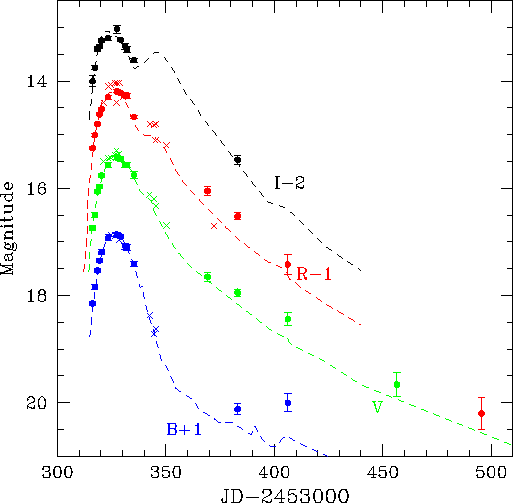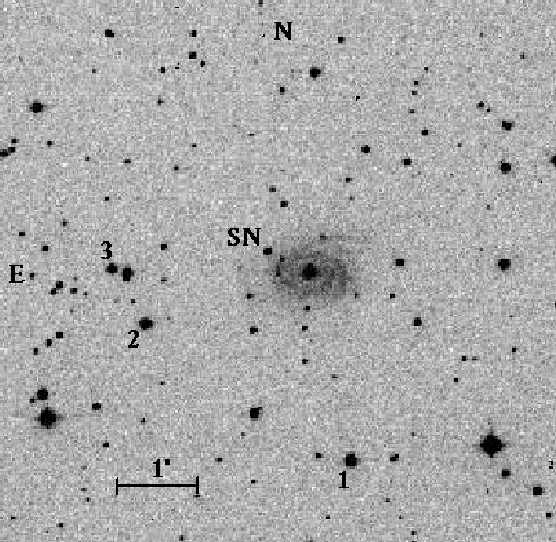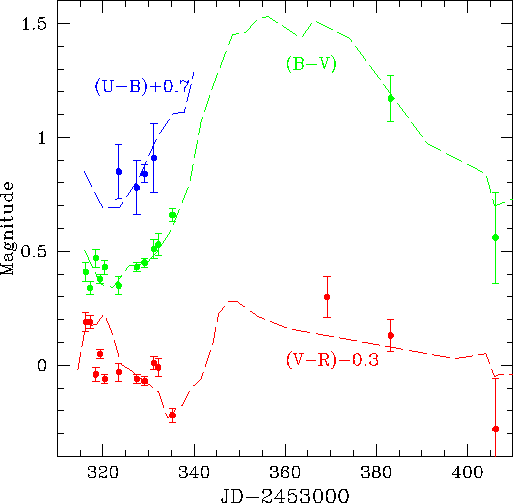|
Peremennye Zvezdy (Variable Stars) 26, No. 4, 2006 Received 1 June; accepted 28 June.
|
Article in PDF |
The light curves of the type Ia Supernova 2004fu
D. Yu. Tsvetkov
- Sternberg Astronomical Institute, University Ave. 13, 119992 Moscow, Russia; e-mail: tsvetkov@sai.msu.su
|
CCD
|
SN 2004fu was discovered by Arbour (2004) on unfiltered CCD images
taken with a 0.3-m Schmidt-Cassegrain reflector on 2004 November
4.87 (approximately at 16![]() 8) and 5.81 (approximately at
16
8) and 5.81 (approximately at
16![]() 5). The new object was located at
5). The new object was located at
![]() (equinox
2000.0), which is
(equinox
2000.0), which is
![]() east and
east and
![]() north of the center
of the Sc galaxy NGC 6949.
north of the center
of the Sc galaxy NGC 6949.
Modjaz et al. (2004) report that a spectrum (range 350-740 nm) of SN 2004fu, obtained on November 10.17 UT with the F. L. Whipple Observatory 1.5-m telescope, shows it to be a type Ia supernova, several days before maximum light.
We started photometric observations of SN 2004fu immediately after discovery, on November 6, with the 60-cm reflector of the Crimean Observatory of the Sternberg Astronomical Institute (C60) equipped with a Roper Scientific VersArray1300B CCD camera, and continued monitoring nearly each night until November 25. On November 22, images were obtained at the 38-cm reflector of the Crimean Astrophysical Observatory (C38) with an Apogee AP-47p CCD camera. Between 2004 December 29 and 2005 March 26, we observed SN 2004fu on four nights at the 70-cm reflector in Moscow (M70) with an AP-47p CCD camera, and on 2005 May 4, the last images were obtained at C60.
The reductions and photometric techniques were described by Tsvetkov (2006) and Tsvetkov et al. (2006). The image of SN 2004fu with comparison stars is shown in Fig. 1. The supernova is far away from the center of the galaxy and from the spiral arms, and the galaxy background does not affect the measurements. The magnitudes of the comparison stars are presented in Table 1, and photometry of the SN is reported in Table 2.
The light curves are shown in Fig. 2, where we also plotted the
data obtained by amateur observers in the ![]() bands as reported
at
bands as reported
at
http://www.astrosurf.com/snweb2/2004/04fu/04fuMeas.htm.
Their data in ![]() are in good agreement with our results, while in
the
are in good agreement with our results, while in
the ![]() and
and ![]() bands some systematic differences can be found. We
achieved excellent photometric coverage of the premaximum rise and
first few days of brightness decline, but later only sporadic
observations were obtained. We can derive dates and magnitudes of
maximum light:
bands some systematic differences can be found. We
achieved excellent photometric coverage of the premaximum rise and
first few days of brightness decline, but later only sporadic
observations were obtained. We can derive dates and magnitudes of
maximum light:
![]() on JD 2453326.3 (November
16.8),
on JD 2453326.3 (November
16.8),
![]() on JD 2453327.2,
on JD 2453327.2,
![]() on
JD2453327.4. The date of maximum light in
on
JD2453327.4. The date of maximum light in ![]() is difficult to
estimate with the same accuracy, as the light curve is quite flat
near the maximum, with
is difficult to
estimate with the same accuracy, as the light curve is quite flat
near the maximum, with
![]() . Using the amateur
data, we can derive the decline rate parameter
. Using the amateur
data, we can derive the decline rate parameter
![]() . We fitted the data to the light curves of the well
studied SN Ia 1994D (Richmond et al., 1995, Altavilla et al.,
2004) with nearly the same value of
. We fitted the data to the light curves of the well
studied SN Ia 1994D (Richmond et al., 1995, Altavilla et al.,
2004) with nearly the same value of
![]() . The
agreement between the light curves of SN 2004fu and 1994D is
nearly perfect in the
. The
agreement between the light curves of SN 2004fu and 1994D is
nearly perfect in the ![]() and
and ![]() bands near maximum, while in
bands near maximum, while in ![]() and
and ![]() some differences are evident. At late stages, the
difference between these objects is prominent in all bands except
some differences are evident. At late stages, the
difference between these objects is prominent in all bands except
![]() .
.
The colour curves for SN 2004fu are shown in Fig. 3 and are
compared to those for SN 1994D. We see a very good agreement
between SN 2004fu and SN 1994D in ![]() and some differences in
and some differences in
![]() . We shifted the
. We shifted the ![]() , and
, and ![]() colour curves
of SN 1994D by 0.5, 0.41 and 0.25 mag, respectively. As the light
of SN 1994D suffered negligible extinction both in the Galaxy and
in the host galaxy (Altavilla et al., 2004), these values
represent the total colour excess for SN 2004fu. Comparing these
data with the estimates of galactic extinction from Schlegel et
al. (1998):
colour curves
of SN 1994D by 0.5, 0.41 and 0.25 mag, respectively. As the light
of SN 1994D suffered negligible extinction both in the Galaxy and
in the host galaxy (Altavilla et al., 2004), these values
represent the total colour excess for SN 2004fu. Comparing these
data with the estimates of galactic extinction from Schlegel et
al. (1998):
![]() , we
conclude that all extinction towards SN 2004fu originated in the
Galaxy. Using these values for extinction along with the distance
modulus
, we
conclude that all extinction towards SN 2004fu originated in the
Galaxy. Using these values for extinction along with the distance
modulus ![]() =33.19 from the LEDA database, we can derive the
absolute magnitudes at maximum light:
=33.19 from the LEDA database, we can derive the
absolute magnitudes at maximum light:
![]() . These values are slightly fainter than the average
luminosity for SNe Ia and are in a good agreement with the
relationship between the decline rate parameter and absolute
magnitude for SNe Ia as presented by Phillips (2005) and Altavilla
et al. (2004).
. These values are slightly fainter than the average
luminosity for SNe Ia and are in a good agreement with the
relationship between the decline rate parameter and absolute
magnitude for SNe Ia as presented by Phillips (2005) and Altavilla
et al. (2004).
We conclude that SN 2004fu is a typical object for its class regarding photometric behavior, with the rate of decline after maximum slightly faster, and the maximum luminosity lower than average, in accordance with the relationship between these parameters for SNe Ia.
Acknowledgements: This research has made use of the Lyon-Meudon Extragalactic Database (LEDA). The author is grateful to I.M. Volkov for help in the observations. The work was partly supported by the grant 05-02-17480 of the Russian Foundation for Basic Research.
References:
Altavilla, G., Fiorentino, G., Marconi, M., et al., 2004, MNRAS, 349, 1344
Arbour, R., 2004, IAU Circ., No. 8428
Modjaz, M., Challis, P., Kirshner, R., Westover, M., 2004, IAU Circ., No. 8436
Richmond, M.W., Treffers, R.R., Filippenko, A.V., et al., 1995, Astron. J., 109, 2121
Phillips, M.M., 2005, in 1604-2004: Supernovae as cosmological lighthouses, M.Turatto et al., eds., ASP Conf. Ser., 342, 211
Schlegel, D., Finkbeiner, D., Davis, M., 1998, Astrophys. J., 500, 525
Tsvetkov, D.Yu., 2006, PZ, 23, No. 3
Tsvetkov, D.Yu., Volnova, A.A., Shulga, A.P., et al., 2006, Astron. & Astrophys. (submitted), astro-ph/0605184
 |
Fig. 2.
|
| Star | ||||||||||
| 1 | 14.66 | 0.06 | 14.59 | 0.03 | 13.85 | 0.04 | 13.34 | 0.02 | 12.92 | 0.02 |
| 2 | 16.00 | 0.04 | 15.25 | 0.04 | 13.96 | 0.03 | 13.19 | 0.03 | 12.55 | 0.02 |
| 3 | 15.73 | 0.07 | 15.25 | 0.04 | 14.22 | 0.04 | 13.59 | 0.03 | 13.12 | 0.02 |
| JD 2453000+ | Tel. | ||||||||||
| 316.22 | 17.15 | 0.04 | 16.74 | 0.04 | 16.25 | 0.03 | 16.00 | 0.10 | C60 | ||
| 317.19 | 16.84 | 0.04 | 16.50 | 0.04 | 16.01 | 0.03 | 15.75 | 0.04 | C60 | ||
| 318.45 | 16.53 | 0.04 | 16.06 | 0.04 | 15.80 | 0.03 | 15.40 | 0.04 | C60 | ||
| 319.35 | 16.35 | 0.04 | 15.97 | 0.04 | 15.62 | 0.03 | 15.36 | 0.04 | C60 | ||
| 320.41 | 16.19 | 0.05 | 15.76 | 0.04 | 15.52 | 0.03 | 15.24 | 0.03 | C60 | ||
| 323.47 | 16.07 | 0.12 | 15.92 | 0.06 | 15.57 | 0.05 | 15.30 | 0.04 | 15.20 | 0.04 | C60 |
| 327.42 | 15.94 | 0.12 | 15.86 | 0.04 | 15.43 | 0.04 | 15.19 | 0.03 | 15.03 | 0.07 | C60 |
| 329.15 | 16.04 | 0.05 | 15.90 | 0.04 | 15.45 | 0.04 | 15.22 | 0.03 | 15.23 | 0.03 | C60 |
| 331.17 | 16.29 | 0.15 | 16.08 | 0.06 | 15.57 | 0.05 | 15.26 | 0.05 | 15.35 | 0.06 | C60 |
| 332.15 | 16.10 | 0.06 | 15.57 | 0.05 | 15.28 | 0.05 | 15.41 | 0.05 | C38 | ||
| 335.25 | 16.41 | 0.05 | 15.75 | 0.06 | 15.67 | 0.03 | 15.61 | 0.04 | C60 | ||
| 369.22 | 17.65 | 0.08 | 17.05 | 0.09 | M70 | ||||||
| 383.15 | 19.12 | 0.10 | 17.95 | 0.07 | 17.52 | 0.06 | 17.47 | 0.09 | M70 | ||
| 406.21 | 19.00 | 0.17 | 18.44 | 0.12 | 18.42 | 0.19 | M70 | ||||
| 456.54 | 19.66 | 0.22 | M70 | ||||||||
| 495.49 | 21.20 | 0.30 | C60 |

